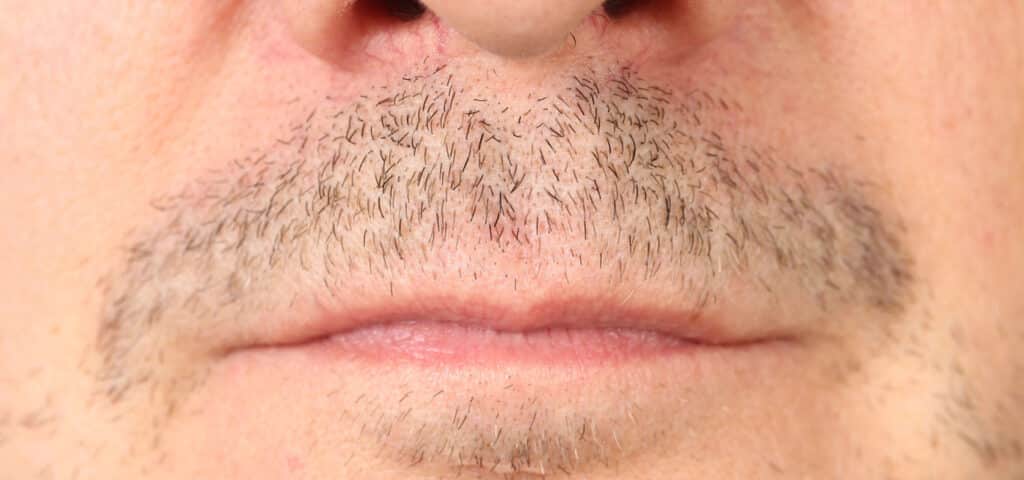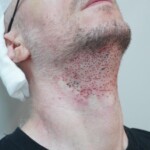A patchy beard is a problem that unfortunately affects many men – regardless of age. For many, a thick, full beard is considered a symbol of masculinity and attractiveness. Unfortunately, a number of factors such as genetics, improper diet, poor grooming, or hormonal imbalances can influence the quality and density of facial hair. In this article, we discuss the causes of patchy beard growth and how to care for it.
What characterizes a patchy beard?
A patchy beard is defined by several key features that distinguish it from a dense, full beard. Above all, in this case, hairs may grow unevenly, creating gaps or thinning areas on the face. Some areas may have very thin hair or appear almost completely bare. The hair in a patchy beard is often thinner and more delicate compared to that of a fuller beard. It may also grow more slowly and appear less visible.

A lack of beard hair is often noticeable in specific areas of the face such as the cheeks, chin, or mustache. Typically, the chin and jawline have less dense hair compared to sideburns. Overall density is reduced, making the beard appear less full. In patchy areas, the skin is more visible, which affects the overall appearance. In some cases, beard irregularity may also be linked to differences in hair color. Lighter hairs are less visible against the skin, further emphasizing the impression of thinning or missing patches.
How to recognize a patchy beard?
A patchy beard is recognized when facial hair grows in irregular intervals, leaving visible gaps between hairs. Some parts of the beard may have noticeably fewer hairs than others, creating an uneven look. Additionally, beard hairs in these areas grow more slowly than on other parts of the body, resulting in sparse, fine facial hair.
How fast does beard hair grow?
On average, men’s facial hair grows about 0.3 to 0.5 mm per day. Over a month, this adds up to 1 to 1.5 cm. For men with patchy beards, the hair may be thinner than scalp hair, making the beard appear less dense. Its shape may also be uneven due to gaps, making it difficult to achieve a uniform look.
What causes a patchy beard?
A patchy beard can result from a variety of factors, including genetics, hormones, and lifestyle. Genetics play a key role in determining beard density. If male relatives in the family have sparse beards, the likelihood of the same issue is high. Genes influence how fast and thick facial hair grows. Hormones – especially DHT – are essential for beard growth. Low levels can lead to poor density. Hormonal imbalances, such as thyroid disorders or androgen deficiencies, can also impact beard growth.
Age is another important factor. Younger men may have patchy growth simply because beard hair takes time to fully develop. As men get older, many notice their beards becoming fuller. Overall health and diet also significantly influence beard growth. Poor nutrition, vitamin and mineral deficiencies, stress, lack of sleep, and other health problems can weaken hair and slow growth. Vitamins B and D, zinc, biotin, and omega-3 fatty acids are especially important.
Poor beard care can also lead to weakening and hair loss. Regular washing and moisturizing are essential for a thick, healthy beard. Harsh cleansers, lack of hydration, and aggressive brushing can damage the hair and skin, leading to thinning. Skin conditions such as dandruff, seborrheic dermatitis, or acne can also reduce beard density. Inflammation damages follicles, leading to patchiness. Exposure to pollution, harsh chemicals, and extreme weather can also harm the skin and hair.
How to stimulate beard growth?
Many men wonder how to stimulate beard growth. First, it’s important to follow a healthy diet rich in vitamins and minerals such as protein, B vitamins, vitamin D, and iron. If diet alone doesn’t provide enough nutrients, supplements may help. Physical exercise improves circulation, supporting nutrient delivery to hair follicles. Regular activity, especially aerobic exercise, supports overall and hormonal health, stimulating growth and improving hair structure.
High stress levels can negatively affect beard growth. Stress-reducing practices such as meditation or yoga may support healthy growth. Proper skincare is also essential. Experts recommend regular exfoliation to remove dead skin cells and prevent ingrown hairs. Beard oils and moisturizers help maintain healthy skin and facial hair. In some cases, doctors may prescribe minoxidil, commonly used for scalp hair loss but shown to stimulate facial hair growth as well.
What helps with weak beard growth? Beard growth products
Patchy beard growth can be stimulated through different methods. Castor oil massaged into the skin may promote new hair growth. Coconut oil, when warmed to liquid form, can also be beneficial. Commercial beard growth products exist, but often do not provide the expected results – making professional help from dermatologists, cosmetologists, or trichologists necessary.
A weak beard may also require a hair transplant. The procedure involves moving follicles from one area of the body to the beard area. Typically, donor hair is harvested using the FUE method, where individual follicles are extracted and then implanted into the skin of the face, creating a new beard line.
Read more: Beard transplant – procedure and results
Men with patchy beards may also consider mesotherapy, where a cocktail of nutrients is injected into the facial skin to stimulate growth. The mixture includes vitamins, minerals, amino acids, and other supportive substances. Another recommended treatment is laser therapy, which stimulates follicles with low-level laser light.
Another effective procedure is PRP therapy using platelet-rich plasma taken from the patient’s own blood. The blood is processed to separate the platelet-rich plasma, which is then injected into areas needing stimulation.
At OT.CO Clinic, we help patients achieve a thick, full beard. We specialize in FUE transplants as well as a wide range of aesthetic medicine treatments tailored to each individual’s needs. Contact us to learn more about our full range of services. We provide patients with comprehensive, personalized support at every stage of therapy.






